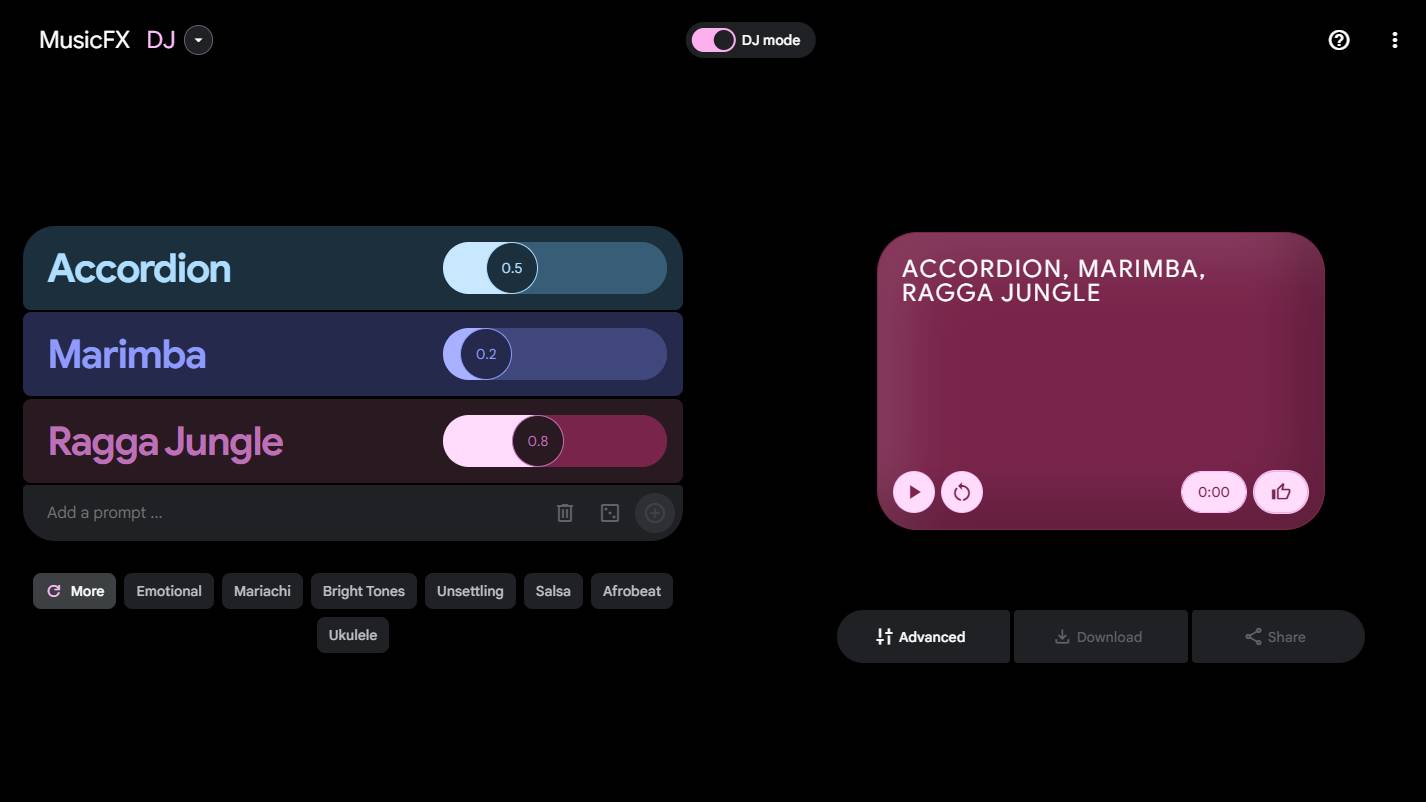I've played with Google's Music FX DJ tool – and it's changed how I think about AI music tools
Hey Mr. DJ, put a record on

When it comes to AI-generated music, I’ve never given it the time of day. But at the recent AI-focused Google I/O 2024 event, something made me rethink my feelings towards AI’s place in music – I’m talking about Google MusicFX DJ Mode, which you can try at this link.
DJ Mode is an extension of Google Music FX, a generative AI tool that forms a 30-second track when you enter a written prompt, or you can select a random one. With DJ Mode, you can create a full DJ set using a similar system by entering prompts such as ‘808 Hip-Hop Beat’ and ‘Viola’, layering them to create a never-ending set. You can even fine-tune each component to make them more present than others.

Even as a fan of all things music, I didn’t come across Google’s AI DJ tool until musician and YouTuber Marc Rebillet appeared at Google I/O 2024, where he crawled out of a giant coffee cup on stage to perform a chaotic set using the DJ Mode tool. That’s when I started paying attention.
Despite never having dabbled in AI music-making platforms, I make a lot of use out of AI integrations in the best music streaming services. To this day, I still think that the Daylist is the best AI feature on Spotify, and one of the best in music streaming overall.
But seeing Rebillet use an AI tool to fuse different sounds and instruments together to create something so wacky but at the same time enjoyable made me want to test it out myself. It never occurred to me that AI-generated music could actually be… fun?
First impressions
I went into my experiment thinking that I’d layer a couple of sounds, get bored of it quickly, and call it a day. 45 minutes later and I’m still engulfed in DJ Mode’s endless sonic whirlpool.
Its web page adopts a very simple design, with the prompt suggestion bar on the left and playback box on the right – so it was very easy to come to grips with. Under the prompt bar, there’s a list of random prompts you can choose from including a ‘More’ button, which refreshes your options when clicked.
Sign up for breaking news, reviews, opinion, top tech deals, and more.
To start my test run, I entered custom prompts to generate a ’90s house-inspired track, and this is where I had my concerns. My first prompt – ‘Deep 90s house bassline’ responded with a sound that resembled ’80s synth pop, so I was immediately questioning DJ Mode’s genre authenticity. Luckily, things started to get better.
Forget Suno and Spotify AI DJ
MusicFX DJ has something that existing AI music tools don’t have; creative freedom. You can add as many custom prompts as you want to layer the sounds, adjust their intensity, and take them out, for an unlimited time – something that platforms such as Suno don’t have.
I have to give Suno praise for its precise genre replication and clever ability to generate lyrics, something that MusicFX DJ lacks. But the fun is temporary, lasting only around two minutes per song.
With features like Spotify’s AI DJ, this is another AI music integration that doesn’t put you in the driver’s seat like MusicFX. Instead, Spotify AI DJ literally just plays you a mix of your ‘On Repeat’ songs while inserting new suggestions here and there – plus the DJ’s voiceover can be jarring, especially when you don’t want any interruptions and breaks in your listening sessions. I can’t say I’ve ever been a fan of it.

A star (DJ) is born
After having my doubts in its ability to interpret my prompts, what surprised me was its fluidity, allowing me to seamlessly go from one sound to the next. And after eventually finding my footing, I became the self-described office DJ.
Starting off with the deep house bassline that disappointed me, I added the prompt ‘piano chords’ which had a jazzy flair. After entering ‘jazz brass’ as my next prompt and lowering the presence of the bassline, I went from house to soft jazz in a matter of minutes.

But the true crowning moment of my time using MusicFX DJ Mode was putting myself to the test and attempting to recreate the style of my favorite artists. Kickstarting this part of my experiment with a ‘train chug beat’ prompt, I layered ‘orchestral strings’, added ‘earthy grit’ and ‘somber viola’, and before I knew it I formed a quintessential early-Bjork track. Enter ‘underground grunge’ and remove the strings, and DJ Mode interprets a Nirvana-style sound.
From there, decreasing ‘underground grunge’ and ‘earthy grit’ prompts made a perfect segue into something more loose and less tense. I replaced the beat with an ‘up-tempo drum’, overlapping a ‘banjo strum’ and ‘flamenco guitar’ pair to produce a Fleetwood Mac track resembling the Rumours era. And I of course couldn’t forget to add Stevie Nicks’ classic tamborine to the mix.

So, I guess I have Marc Rebillet to thank for introducing me to the magic of MusicFX DJ Mode and opening my eyes to AI-generated music for casual use. Perhaps it has its place, and although the big fat question mark over it hasn’t gone away just yet for me, this is certainly the starting point of me warming up to casual AI music-making tools.
You might also like

Rowan is an Editorial Associate and Apprentice Writer for TechRadar. A recent addition to the news team, he is involved in generating stories for topics that spread across TechRadar's categories. His interests in audio tech and knowledge in entertainment culture help bring the latest updates in tech news to our readers.